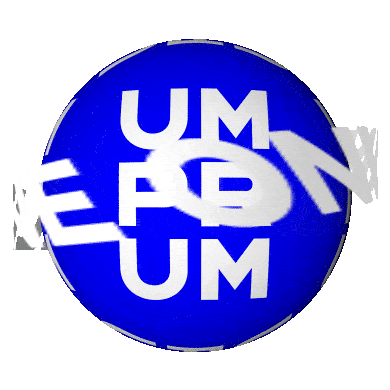


Bodies and their extensions in the centre of design research
– An Interview with Ines Borovac and Rebecca Schedler
We met Rebecca Schedler and Ines Borovac at UMPRUM on the occasion of their lecture for the K.O.V. students. We had an almost hour-long conversation about studying in the Netherlands, their professional practice, the current limitations of design work, and other inspiring topics — fragments of which I present in this interview. Enjoy a pleasant and thought-provoking read!
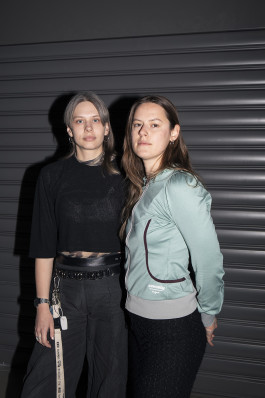
Rebecca Schedler and Ines Borovac.
Photo: Šimona Němečková
Agáta Hošnová: You both graduated from the MA in Social Design at Design Academy Eindhoven, which is, in the European context, quite a unique department. How have your studies shaped your practices?
Rebecca: Coming from a background in textiles, I was really thirsty to connect to something different after graduating, something more conceptual. I still appreciate the crafts and technologies involved in textile production, but that doesn’t take away from the fact that the textile industry is one of the most polluting. Through the social design course, I managed to connect much deeper with more-than-human environments, social issues and sustainability, creating different narratives from various perspectives.
Ines: I studied industrial design in Croatia and then I started working for a retail company. For my Masters Degree, I chose Social Design because of one particular project by Elisa Otanez, a graduate from the programme. Her final project, Yellow Spot, is about the difficulties and disbalance of access to toilets for women in public space. Her intervention was based on placing mobile cabin toilets in different public spaces in Eindhoven as a protest for the lack of female toilets outdoors, responding as well to the fact that most designers working in public space infrastructure and urbanism are men. I was really inspired by this approach of connecting design to social structures and viewing design as a tool for better understanding our society, and vice versa.
I can see what you’re talking about. When I visited Design Academy Eindhoven, I felt that DAE’s students really emphasized the need for critical research in design. I get the sense that here at UMPRUM, quite a lot of our design practices are based on creation of physical objects and driven by, for instance, material research, rather than social engagement and exploration of deeper systemic and cultural issues.
Rebecca: Well, for instance, when we saw all the workshops at the Technological Center in Mikulandská, we were amazed by the facilities and all the machinery you have available here. It is quite exceptional! Incomparable to our facilities at DAE.
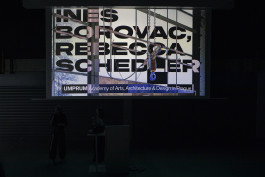
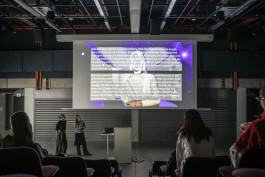
You held a lecture and a workshop for K. O. V. students here at UMPRUM – a studio which translates as “concept-object-meaning.” What was the workshop about and how did it go?
Ines: The workshop was called “Transmutational Matter”. The initial idea was to invite students to bring an everyday object their body interacts with on a daily basis. We then treated these objects as bodies of their own. We explored their anatomy, we deconstructed them. Through this workshop, we wanted to emphasize what, besides jewelry, could be an extension of a body with greater value. We tried to recreate these objects by emphasizing certain bodily movements or senses. On the last day, attendees had to present this experiment as a performance in a public space. This workshop is also inspired by post-humanist ideas and avant-garde artists who did similar things in their own time, but today it feels more concerned with our protection and anxieties over technology.
What kind of objects did the students bring?
Ines: Spoons, jewelry, phones, ribbons, knives, rulers, aluminium foil, textiles, chopsticks, headphones, computers… many different things with a lot of potential for this sort of exercise. We also showed them examples of artists who have worked with body-object-concept relations like Rebecca Horn and her performances with gigantic prosthetics attached to her fingers – Finger Gloves (1972). There’s another fascinating project by British artist Thomas Thwaites, where he went to the Alps to spend three days as a goat. Literally. In his work A holiday from being human (GoatMan) (2016), he was wearing prosthetic goat legs, eating grass, and socialising with a horde of goats. What is quite curious is that they did actually accept him amongst themselves.
What inspirations and resources for your design practices would you recommend to emerging designers at UMPRUM?
Ines & Rebecca: We both think it’s really important to read – books, magazines, interviews… and to try to gain as much first hand knowledge as possible. This also means knowing the art historical links between the topics you engage with and be aware of curatorial trends, but remain truthful to your emotions and curiosity. Focus on a problem or draw inspiration from your surroundings and work with that. You can also follow theorists that inspire you – for us, we can name Judith Butler, Silvia Federici, Helen Hester, Julia Kristeva…
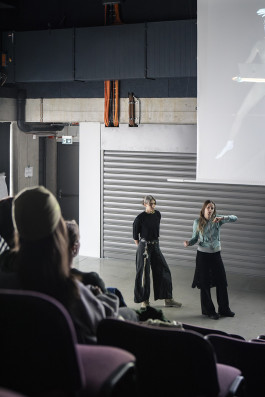
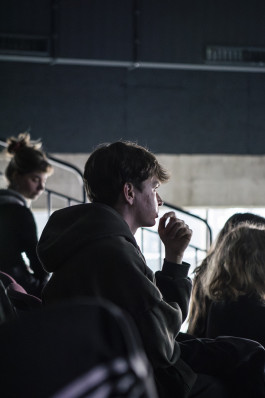
Ines, you say in your bio that you focus on performative design. What do you mean by that?
Ines: After my graduation, I decided to call myself a performative designer because it was the only way that I could describe what I was doing – researching with and through the body and through movement and bodily memory. I use these tools to archive the repercussions of social systems, objects or spaces. I ask myself questions like, why do we sit the way we sit? Why do we move the way we move? Why do women avoid parts of the city men don’t? I believe that this is the way that we as designers design things, which then sprout into different choreographies embedded into our corporeality. I think about gestures – anything we design, any object, comes with a gesture – sitting, scrolling your phone, opening doors… I believe all these moments influence our values and our internal self.
Talking about the body, you mentioned your focus on Balkan culture. I was quite struck by that and I was wondering if you feel that there are some general misconceptions of the “Balkan body,” if there is even such a thing?
Ines: Yeah, I think there definitely are some connotations – Balkan society is seen as highly patriarchal, a bit barbarian, a bit forgotten by the rest of Europe, a weird mesh of countries that no one really understands. And I think the “Balkan body” is a very oppressed body in the European context, and carries a lot of normalised oppression. That is why I did my graduation project COLLO – redancing tradition (2021) about Croatian folk dances – I wanted to show what nationalistic concepts and ideals can teach us about patriarchal values through the body, without saying anything verbally, just through movement. I think that my projects always come from a position of seeing a certain problem, pointing fingers at it, and then deconstructing and transforming it into something useful.
One of your recent projects was A Girl, A Wedding & a Sacrifice (2023). How did you come up with this idea?
Ines: I was researching and comparing dating apps and Balkan courting rituals when I met Juliette Mirabito, a curator from Rotterdam’s Rib gallery, where they were doing a food program inspired by FOOD, an artist-run restaurant from the 1970s rooted in New York’s avant-garde scene. Juliette invited me to participate in it with a performance that was staged as a wedding dinner. Thinking about Balkan weddings, I needed to incorporate the heart of this festivity – a roasted lamb, a traditional sacrifice bound to Christianity and new beginnings. I told the curator I would like to roast the lamb in a gallery as a sacrifice for a successful delivery of my upcoming project Why wouldn't you date me? (2024). So, I symbolically sacrificed the lamb for that project.
So it was like a precursor to Why wouldn’t you date me?
Ines: Yes. It was not purely an appropriation of this cultural phenomena – I wanted to approach it more critically. In preparation for the performance, I visited a goat farm and selected a lamb to be sacrificed. This interaction was filmed, and the video was screened behind me as I was chopping and preparing the lamb for the visitors of the gallery. I was serving the tradition, visitors were eating it.
You mentioned that you didn't kill the lamb – I think that would be the final point to make the performance complete.
Ines: Yeah, I agree, I would have done it but it was impossible for legal reasons. It would have definitely been the most challenging part of it.
My last question to you, Ines, relates to the performance about dating you mentioned. For this project, you were live-streaming your dates onto a public square in your hometown in Croatia. The audience could then give you prompts on your behaviour. How did the public interact with this?
Ines: I think the audience was pretty excited! One of my main inspirations for this project comes from my obsession with reality TV and dating programmes. When I was live streaming this to Croatia, I went on a few dates over a couple of days, and there were some people who would “come” to all the dates even though they were always taking place at the same location.
You were also changing the status of dating – you were making something private public and sort of gamifying the whole process. Why did you want to remove the intimacy and make it available to anyone watching?
Ines: The whole project emerged from researching how European courting rituals used to be surveilled by the whole village. For example, as a woman, if you went on a date with someone, your whole family and the village would surveil you so you didn’t do anything naughty. You would then be pushed to get married because your family needed either a working force or money. It was intriguing to see how the female body was used as a currency between different male agents to strengthen the homosocial relations. Placing it in the contexts of online dating scenarios, I was then thinking about how it is no longer only female bodies, but all bodies on these apps that are exploited for the sake of providing personal data so that the white tech bros owning these companies can get rich again under the skies of love. On the net, we may live in an illusion that our data, choices and information are private, but they are actually extremely public.
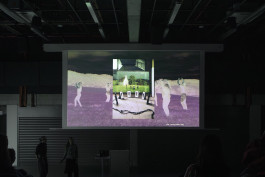
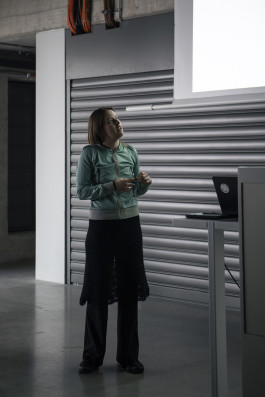
Let’s now move to you, Rebecca. You started as a textile designer and you said that some of the reasons why you stopped were ethical. How did this transformation from industrial textile manufacturing to a more experimental DIY practice go for you?
Rebecca: When working with textiles, I believe that one has to think a lot about surfaces and facades. It was not enough for me, I wanted to dive deeper, to learn more about processes of circular economics of reusing and recycling. As well as this, I have always loved horror movies, steampunk, and have had an unusual fascination with the abject. I was curious to see how our perception of certain situations changed in various settings – like a snail in a garden is totally fine, but a snail in someone’s bed is perceived as disgusting.
In your bio, you also mention that you are drawn to examining various intersecting systems. What is a particular example of this?
Rebecca: I am curious about the moment when something omnipresent becomes obscure and taboo. For instance, in my research, I have been looking into sewage systems and the circulation of human faeces. Sewage systems – outdated engineering complexes which should be reconsidered – are massive underground networks of waste water from which we can learn a lot about each city and its inhabitants. This “abject” liquid solution can sustain a very healthy soil and can be used as a forensic tool to learn about many different issues, including in the field of criminology. The sewage reflects the fecal microbial community of human populations and reveals population-level characteristics of the human microbiome, for example, how much of the local population is overweight.
I guess we can still see some infrastructural systems within textiles as well – for instance, I have seen some projects at DAE that used textiles as growing soil for different biosystems, thus entering into wider interactions.
Rebecca: Definitely, there is for instance this project Unravelling the Coffee Bag (2021), by Rosana Escobar, a graduate of MA Contextual design at Design Academy Eindhoven, where she was reusing coffee bags as textile materials for garments.
This example with coffee bags brings me to your ongoing research about waste materials and their productive potential. A few of your projects have transformed human excrements into fertilisers. Why are you fascinated by this niche material and where do you see its potential?
Rebecca: I think as humans, we only have a couple of taboos – one of them is talking about your own sexuality, and another one is shit. However, faeces are, actually, a very valuable material with a lot of transformative potential. For me, looking into the discarded or disregarded materials or organisms presents so much benefit for ecological, humanist and more-than-human thinking. Then, what is taboo for too long can become a big problem.
Do you think that more designers would engage with shit if there wasn't such stigma around it?
Rebecca: Well, it is messy and it is smelly – it is definitely not for everyone. But I think it's changing as well. For instance, in Italy, there is Museo della Merda where they produce all different products from cow shit – anything from furniture to plates. They burn it in a special kiln so all the bacteria is then dead – it is a good example of reuse of waste material.
What do you see are some of the major issues with the current state of soil fertilisation?
Rebecca: We can sometimes observe loss of microbes in the soil, resulting in a real threat of desertification in Europe. This means that the soil is slowly degrading into sand. An inspiring example is, for instance, a company called Circle Carbon Labs, based in Mallorca, which promotes education on soil health and food sustainability. They reuse a lot of waste material from Mallorca and either compost it or burn it to create biochar, a very effective fertilizer which invites the growth of healthy microbes. By applying organic biochar to the soils, the nutrients present in soil can be better stored, the delivery and bioavailability of nutrients improved which in turn leads to more efficient results in plants and vegetables growth.
Final question – what are you currently working on, Rebecca?
Rebecca: I am currently teaching at the Living Station Lab, an educational platform looking into growing materials and creating bioplastics. This initiative is part of Willem de Kooning Academy in Rotterdam. I also focus on my own artistic endeavours – I am doing a multimedia project at WORM, a cinema/club/bar/gallery in Rotterdam, creating an exhibition there rooted in its long standing history and its community. The pieces I created are offering a glimpse into a world where the Worm building is not just a space but a living, breathing organism. Be it unseen footage including a porn couple filmed in the old building, mushrooms growing on bar waste, spit from the dance floor or floating latex sculptures (made in cooperation with Rachel Refael).
You mentioned this curiosity of exchanging body fluids and examining what we leave on surfaces in the lecture you had.
Rebecca: Yes, exactly. I am also creating maps of the place and its sewage piping. It is a long-durational reinvention and rediscovery of the space, framed by constant transformation — the usual process of my creative practice.
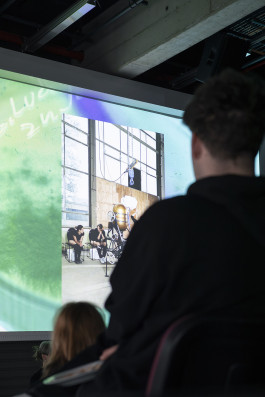
Author: Agáta Hošnová
Photo: Šimona Němečková
Ines Borovac is a Croatian multidisciplinary artist based in Amsterdam, the Netherlands. She holds a master’s degree in Social Design from the Design Academy in Eindhoven where she developed her practice in the field of performative design. Inspired by her cultural background and personal experiences, the ubiquitous themes of her work are socio-political issues of Balkan region. As a feminist in her practice, Borovac infiltrates various traditional systems with the aim to create alternate speculative scenarios. The foundation of Borovac’ artistic practice unfolds through movement/gesture whereby she studies the behaviors and rituals of social constructs, with a focus on gender roles in Balkan culture. Possible futures, systems and rituals become proposed and materialized through video, performance and installation. Since 2022 together with Ginevra Petrozzi, Borovac has been working as a co-founder of art and design duo Xsenofemme. Her work has been exhibited at Kunstinstituut Melly, Museum for Contemporary Art Zagreb, Ars Electronica, MU hybrid house, Onomatopee Net, Garage Rotterdam, FRAC among others.
inesborovac.com
Rebecca Schedler is a designer and researcher from Germany. She investigates complex relations between social, cultural, political, and environmental issues by exploring the intersection of design and science. Her work deals with interspecies interactions, technology, taken-for-granted materials, such as mushrooms and shit, and how these could lead to a more shared and equal future. Through a Bioreactor-system, she explores hidden systems, the unseen and the abject, which form a vital part of our environment and living space with their life, age, and death. Rebecca graduated from the Design Academy Eindhoven (NL) with a Master's in Social Design and holds a Bachelor's degree in Textile- and Surface Design from the Kunsthochschule Weißensee Berlin (DE). She is currently active as a tutor and instructor at the Living Station Lab within the Willem de Kooning Academy.
rebecca-schedler.com
Agáta Hošnová is a graduate of the BA in Curating at Goldsmiths College and the MA in Arts Management at King's College London. She is currently continuing her studies at the Department of Theory and History of Art at UMPRUM. She works at the Prague City Gallery and is an independent curator, currently a guest curator at Berlinskej model gallery. She is interested in the possibilities of curatorial theory and practice, the intermedial overlaps of the moving image and art from the second half of the 20th century to the present.
Bodies and their extensions in the centre of design research
– An Interview with Ines Borovac and Rebecca Schedler
We met Rebecca Schedler and Ines Borovac at UMPRUM on the occasion of their lecture for the K.O.V. students. We had an almost hour-long conversation about studying in the Netherlands, their professional practice, the current limitations of design work, and other inspiring topics — fragments of which I present in this interview. Enjoy a pleasant and thought-provoking read!

Rebecca Schedler and Ines Borovac.
Photo: Šimona Němečková
Agáta Hošnová: You both graduated from the MA in Social Design at Design Academy Eindhoven, which is, in the European context, quite a unique department. How have your studies shaped your practices?
Rebecca: Coming from a background in textiles, I was really thirsty to connect to something different after graduating, something more conceptual. I still appreciate the crafts and technologies involved in textile production, but that doesn’t take away from the fact that the textile industry is one of the most polluting. Through the social design course, I managed to connect much deeper with more-than-human environments, social issues and sustainability, creating different narratives from various perspectives.
Ines: I studied industrial design in Croatia and then I started working for a retail company. For my Masters Degree, I chose Social Design because of one particular project by Elisa Otanez, a graduate from the programme. Her final project, Yellow Spot, is about the difficulties and disbalance of access to toilets for women in public space. Her intervention was based on placing mobile cabin toilets in different public spaces in Eindhoven as a protest for the lack of female toilets outdoors, responding as well to the fact that most designers working in public space infrastructure and urbanism are men. I was really inspired by this approach of connecting design to social structures and viewing design as a tool for better understanding our society, and vice versa.
I can see what you’re talking about. When I visited Design Academy Eindhoven, I felt that DAE’s students really emphasized the need for critical research in design. I get the sense that here at UMPRUM, quite a lot of our design practices are based on creation of physical objects and driven by, for instance, material research, rather than social engagement and exploration of deeper systemic and cultural issues.
Rebecca: Well, for instance, when we saw all the workshops at the Technological Center in Mikulandská, we were amazed by the facilities and all the machinery you have available here. It is quite exceptional! Incomparable to our facilities at DAE.


You held a lecture and a workshop for K. O. V. students here at UMPRUM – a studio which translates as “concept-object-meaning.” What was the workshop about and how did it go?
Ines: The workshop was called “Transmutational Matter”. The initial idea was to invite students to bring an everyday object their body interacts with on a daily basis. We then treated these objects as bodies of their own. We explored their anatomy, we deconstructed them. Through this workshop, we wanted to emphasize what, besides jewelry, could be an extension of a body with greater value. We tried to recreate these objects by emphasizing certain bodily movements or senses. On the last day, attendees had to present this experiment as a performance in a public space. This workshop is also inspired by post-humanist ideas and avant-garde artists who did similar things in their own time, but today it feels more concerned with our protection and anxieties over technology.
What kind of objects did the students bring?
Ines: Spoons, jewelry, phones, ribbons, knives, rulers, aluminium foil, textiles, chopsticks, headphones, computers… many different things with a lot of potential for this sort of exercise. We also showed them examples of artists who have worked with body-object-concept relations like Rebecca Horn and her performances with gigantic prosthetics attached to her fingers – Finger Gloves (1972). There’s another fascinating project by British artist Thomas Thwaites, where he went to the Alps to spend three days as a goat. Literally. In his work A holiday from being human (GoatMan) (2016), he was wearing prosthetic goat legs, eating grass, and socialising with a horde of goats. What is quite curious is that they did actually accept him amongst themselves.
What inspirations and resources for your design practices would you recommend to emerging designers at UMPRUM?
Ines & Rebecca: We both think it’s really important to read – books, magazines, interviews… and to try to gain as much first hand knowledge as possible. This also means knowing the art historical links between the topics you engage with and be aware of curatorial trends, but remain truthful to your emotions and curiosity. Focus on a problem or draw inspiration from your surroundings and work with that. You can also follow theorists that inspire you – for us, we can name Judith Butler, Silvia Federici, Helen Hester, Julia Kristeva…


Ines, you say in your bio that you focus on performative design. What do you mean by that?
Ines: After my graduation, I decided to call myself a performative designer because it was the only way that I could describe what I was doing – researching with and through the body and through movement and bodily memory. I use these tools to archive the repercussions of social systems, objects or spaces. I ask myself questions like, why do we sit the way we sit? Why do we move the way we move? Why do women avoid parts of the city men don’t? I believe that this is the way that we as designers design things, which then sprout into different choreographies embedded into our corporeality. I think about gestures – anything we design, any object, comes with a gesture – sitting, scrolling your phone, opening doors… I believe all these moments influence our values and our internal self.
Talking about the body, you mentioned your focus on Balkan culture. I was quite struck by that and I was wondering if you feel that there are some general misconceptions of the “Balkan body,” if there is even such a thing?
Ines: Yeah, I think there definitely are some connotations – Balkan society is seen as highly patriarchal, a bit barbarian, a bit forgotten by the rest of Europe, a weird mesh of countries that no one really understands. And I think the “Balkan body” is a very oppressed body in the European context, and carries a lot of normalised oppression. That is why I did my graduation project COLLO – redancing tradition (2021) about Croatian folk dances – I wanted to show what nationalistic concepts and ideals can teach us about patriarchal values through the body, without saying anything verbally, just through movement. I think that my projects always come from a position of seeing a certain problem, pointing fingers at it, and then deconstructing and transforming it into something useful.
One of your recent projects was A Girl, A Wedding & a Sacrifice (2023). How did you come up with this idea?
Ines: I was researching and comparing dating apps and Balkan courting rituals when I met Juliette Mirabito, a curator from Rotterdam’s Rib gallery, where they were doing a food program inspired by FOOD, an artist-run restaurant from the 1970s rooted in New York’s avant-garde scene. Juliette invited me to participate in it with a performance that was staged as a wedding dinner. Thinking about Balkan weddings, I needed to incorporate the heart of this festivity – a roasted lamb, a traditional sacrifice bound to Christianity and new beginnings. I told the curator I would like to roast the lamb in a gallery as a sacrifice for a successful delivery of my upcoming project Why wouldn't you date me? (2024). So, I symbolically sacrificed the lamb for that project.
So it was like a precursor to Why wouldn’t you date me?
Ines: Yes. It was not purely an appropriation of this cultural phenomena – I wanted to approach it more critically. In preparation for the performance, I visited a goat farm and selected a lamb to be sacrificed. This interaction was filmed, and the video was screened behind me as I was chopping and preparing the lamb for the visitors of the gallery. I was serving the tradition, visitors were eating it.
You mentioned that you didn't kill the lamb – I think that would be the final point to make the performance complete.
Ines: Yeah, I agree, I would have done it but it was impossible for legal reasons. It would have definitely been the most challenging part of it.
My last question to you, Ines, relates to the performance about dating you mentioned. For this project, you were live-streaming your dates onto a public square in your hometown in Croatia. The audience could then give you prompts on your behaviour. How did the public interact with this?
Ines: I think the audience was pretty excited! One of my main inspirations for this project comes from my obsession with reality TV and dating programmes. When I was live streaming this to Croatia, I went on a few dates over a couple of days, and there were some people who would “come” to all the dates even though they were always taking place at the same location.
You were also changing the status of dating – you were making something private public and sort of gamifying the whole process. Why did you want to remove the intimacy and make it available to anyone watching?
Ines: The whole project emerged from researching how European courting rituals used to be surveilled by the whole village. For example, as a woman, if you went on a date with someone, your whole family and the village would surveil you so you didn’t do anything naughty. You would then be pushed to get married because your family needed either a working force or money. It was intriguing to see how the female body was used as a currency between different male agents to strengthen the homosocial relations. Placing it in the contexts of online dating scenarios, I was then thinking about how it is no longer only female bodies, but all bodies on these apps that are exploited for the sake of providing personal data so that the white tech bros owning these companies can get rich again under the skies of love. On the net, we may live in an illusion that our data, choices and information are private, but they are actually extremely public.


Let’s now move to you, Rebecca. You started as a textile designer and you said that some of the reasons why you stopped were ethical. How did this transformation from industrial textile manufacturing to a more experimental DIY practice go for you?
Rebecca: When working with textiles, I believe that one has to think a lot about surfaces and facades. It was not enough for me, I wanted to dive deeper, to learn more about processes of circular economics of reusing and recycling. As well as this, I have always loved horror movies, steampunk, and have had an unusual fascination with the abject. I was curious to see how our perception of certain situations changed in various settings – like a snail in a garden is totally fine, but a snail in someone’s bed is perceived as disgusting.
In your bio, you also mention that you are drawn to examining various intersecting systems. What is a particular example of this?
Rebecca: I am curious about the moment when something omnipresent becomes obscure and taboo. For instance, in my research, I have been looking into sewage systems and the circulation of human faeces. Sewage systems – outdated engineering complexes which should be reconsidered – are massive underground networks of waste water from which we can learn a lot about each city and its inhabitants. This “abject” liquid solution can sustain a very healthy soil and can be used as a forensic tool to learn about many different issues, including in the field of criminology. The sewage reflects the fecal microbial community of human populations and reveals population-level characteristics of the human microbiome, for example, how much of the local population is overweight.
I guess we can still see some infrastructural systems within textiles as well – for instance, I have seen some projects at DAE that used textiles as growing soil for different biosystems, thus entering into wider interactions.
Rebecca: Definitely, there is for instance this project Unravelling the Coffee Bag (2021), by Rosana Escobar, a graduate of MA Contextual design at Design Academy Eindhoven, where she was reusing coffee bags as textile materials for garments.
This example with coffee bags brings me to your ongoing research about waste materials and their productive potential. A few of your projects have transformed human excrements into fertilisers. Why are you fascinated by this niche material and where do you see its potential?
Rebecca: I think as humans, we only have a couple of taboos – one of them is talking about your own sexuality, and another one is shit. However, faeces are, actually, a very valuable material with a lot of transformative potential. For me, looking into the discarded or disregarded materials or organisms presents so much benefit for ecological, humanist and more-than-human thinking. Then, what is taboo for too long can become a big problem.
Do you think that more designers would engage with shit if there wasn't such stigma around it?
Rebecca: Well, it is messy and it is smelly – it is definitely not for everyone. But I think it's changing as well. For instance, in Italy, there is Museo della Merda where they produce all different products from cow shit – anything from furniture to plates. They burn it in a special kiln so all the bacteria is then dead – it is a good example of reuse of waste material.
What do you see are some of the major issues with the current state of soil fertilisation?
Rebecca: We can sometimes observe loss of microbes in the soil, resulting in a real threat of desertification in Europe. This means that the soil is slowly degrading into sand. An inspiring example is, for instance, a company called Circle Carbon Labs, based in Mallorca, which promotes education on soil health and food sustainability. They reuse a lot of waste material from Mallorca and either compost it or burn it to create biochar, a very effective fertilizer which invites the growth of healthy microbes. By applying organic biochar to the soils, the nutrients present in soil can be better stored, the delivery and bioavailability of nutrients improved which in turn leads to more efficient results in plants and vegetables growth.
Final question – what are you currently working on, Rebecca?
Rebecca: I am currently teaching at the Living Station Lab, an educational platform looking into growing materials and creating bioplastics. This initiative is part of Willem de Kooning Academy in Rotterdam. I also focus on my own artistic endeavours – I am doing a multimedia project at WORM, a cinema/club/bar/gallery in Rotterdam, creating an exhibition there rooted in its long standing history and its community. The pieces I created are offering a glimpse into a world where the Worm building is not just a space but a living, breathing organism. Be it unseen footage including a porn couple filmed in the old building, mushrooms growing on bar waste, spit from the dance floor or floating latex sculptures (made in cooperation with Rachel Refael).
You mentioned this curiosity of exchanging body fluids and examining what we leave on surfaces in the lecture you had.
Rebecca: Yes, exactly. I am also creating maps of the place and its sewage piping. It is a long-durational reinvention and rediscovery of the space, framed by constant transformation — the usual process of my creative practice.

Author: Agáta Hošnová
Photo: Šimona Němečková
Ines Borovac is a Croatian multidisciplinary artist based in Amsterdam, the Netherlands. She holds a master’s degree in Social Design from the Design Academy in Eindhoven where she developed her practice in the field of performative design. Inspired by her cultural background and personal experiences, the ubiquitous themes of her work are socio-political issues of Balkan region. As a feminist in her practice, Borovac infiltrates various traditional systems with the aim to create alternate speculative scenarios. The foundation of Borovac’ artistic practice unfolds through movement/gesture whereby she studies the behaviors and rituals of social constructs, with a focus on gender roles in Balkan culture. Possible futures, systems and rituals become proposed and materialized through video, performance and installation. Since 2022 together with Ginevra Petrozzi, Borovac has been working as a co-founder of art and design duo Xsenofemme. Her work has been exhibited at Kunstinstituut Melly, Museum for Contemporary Art Zagreb, Ars Electronica, MU hybrid house, Onomatopee Net, Garage Rotterdam, FRAC among others.
inesborovac.com
Rebecca Schedler is a designer and researcher from Germany. She investigates complex relations between social, cultural, political, and environmental issues by exploring the intersection of design and science. Her work deals with interspecies interactions, technology, taken-for-granted materials, such as mushrooms and shit, and how these could lead to a more shared and equal future. Through a Bioreactor-system, she explores hidden systems, the unseen and the abject, which form a vital part of our environment and living space with their life, age, and death. Rebecca graduated from the Design Academy Eindhoven (NL) with a Master's in Social Design and holds a Bachelor's degree in Textile- and Surface Design from the Kunsthochschule Weißensee Berlin (DE). She is currently active as a tutor and instructor at the Living Station Lab within the Willem de Kooning Academy.
rebecca-schedler.com
Agáta Hošnová is a graduate of the BA in Curating at Goldsmiths College and the MA in Arts Management at King's College London. She is currently continuing her studies at the Department of Theory and History of Art at UMPRUM. She works at the Prague City Gallery and is an independent curator, currently a guest curator at Berlinskej model gallery. She is interested in the possibilities of curatorial theory and practice, the intermedial overlaps of the moving image and art from the second half of the 20th century to the present.